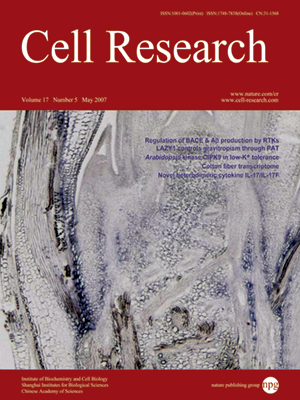
Volume 17, No 5, May 2007
ISSN: 1001-0602
EISSN: 1748-7838 2018
impact factor 17.848*
(Clarivate Analytics, 2019)
Volume 17 Issue 5, May 2007: 471-482
ORIGINAL ARTICLES
Disruption of phytoene desaturase gene results in albino and dwarf phenotypes in Arabidopsis by impairing chlorophyll, carotenoid, and gibberellin biosynthesis
Genji Qin1, Hongya Gu1,2, Ligeng Ma1,3, Yiben Peng1, Xing Wang Deng1,3, Zhangliang Chen1 and Li-Jia Qu1,2
1Peking-Yale Joint Center for Plant Molecular Genetics and Agrobiotechnology, National Laboratory for Protein Engineering and Plant Genetic Engineering, College of Life Sciences, Peking University, Beijing 100871, China;
2The National Plant Gene Research Center (Beijing), Beijing 100101, China;
3Department of Molecular, Cellular, and Developmental Biology, Yale University, New Haven Connecticut 62520-8104, USA
Correspondence: Li-Jia Qu(qulj@pku.edu.cn)
Carotenoids play an important role in many physiological processes in plants and the phytoene desaturase gene (
PDS3) encodes one of the important enzymes in the carotenoid biosynthesis pathway. Here we report the identification and analysis of a T-DNA insertion mutant of
PDS3 gene. Functional complementation confirmed that both the albino and dwarf phenotypes of the
pds3 mutant resulted from functional disruption of the
PDS3 gene. Chloroplast development was arrested at the proplastid stage in the
pds3 mutant. Further analysis showed that high level of phytoene was accumulated in the
pds3 mutant. Addition of exogenous GA
3 could partially rescue the dwarf phenotype, suggesting that the dwarf phenotype of the
pds3 mutant might be due to GA deficiency. Microarray and RT-PCR analysis showed that disrupting
PDS3 gene resulted in gene expression changes involved in at least 20 metabolic pathways, including the inhibition of many genes in carotenoid, chlorophyll, and GA biosynthesis pathways. Our data suggest that the accumulated phytoene in the
pds3 mutant might play an important role in certain negative feedbacks to affect gene expression of diverse cellular pathways.
Cell Research (2007) 17: 471-482. doi: 10.1038/cr.2007.40; published online 8 May 2007
FULL TEXT | PDF
Browse 1983


